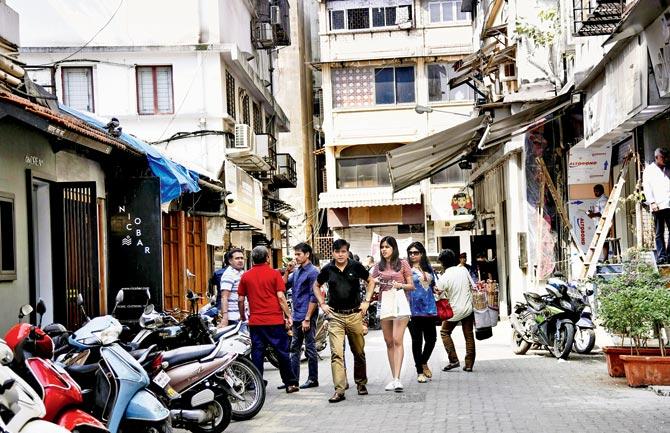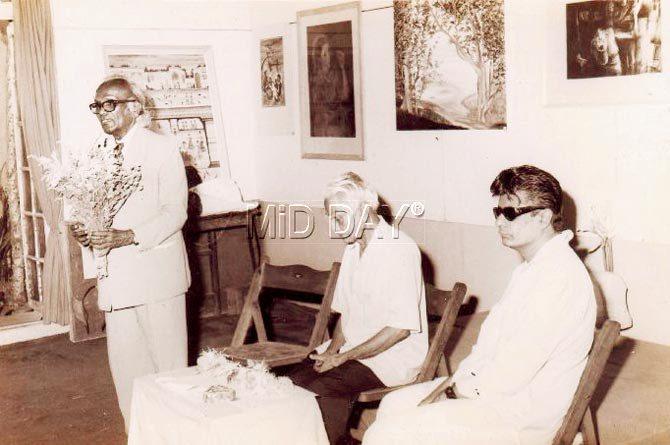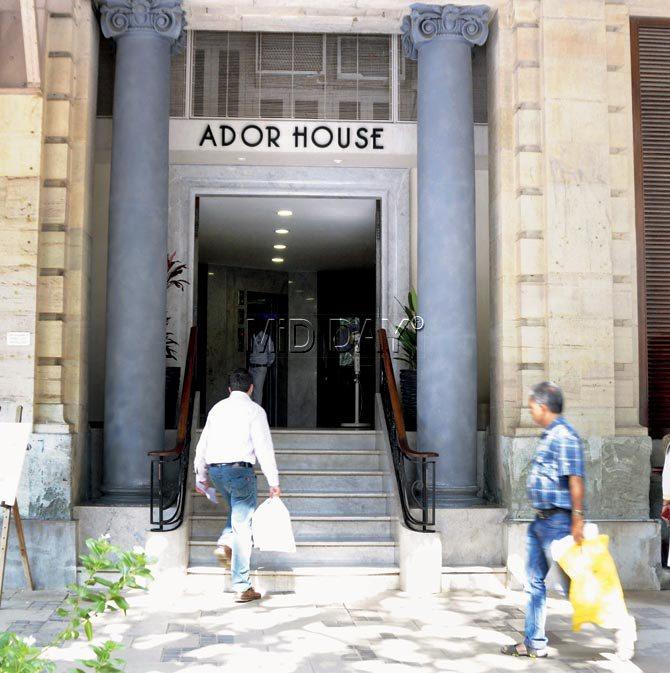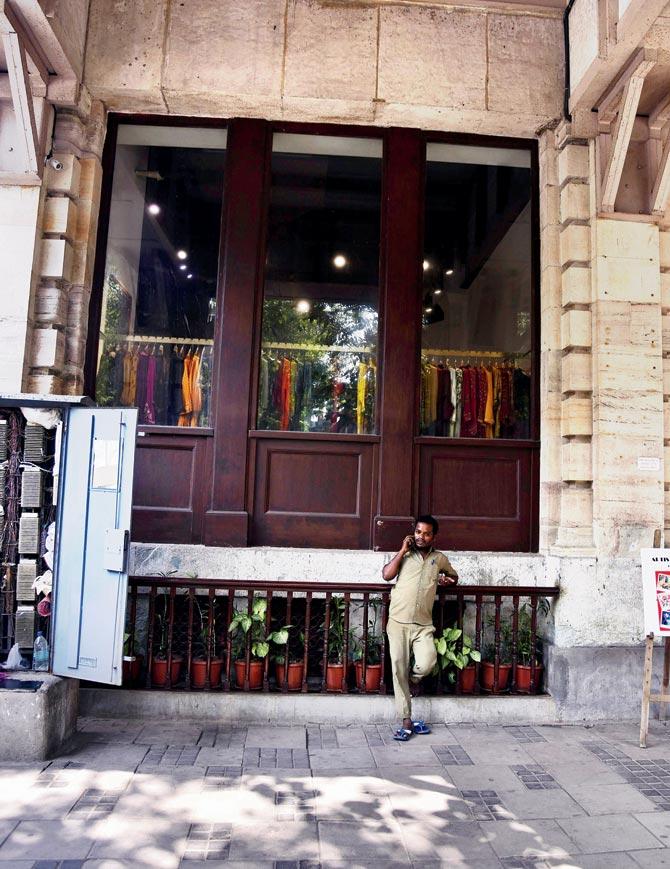As landlords welcome market rent payers and the city's only 'art district' metamorphoses into a luxe shopping plaza, is the boom we celebrated for reviving SoBo proving adverse?

Walking along Rampart Row in Kala Ghoda, it's hard to tell that one of the windows of the five-storeyed Ador House used to be the cherished vista of the famed painter KH Ara. One of the founding members of the Bombay Progressives, Ara had his studio on the first floor. That modest studio exists today as the office space for Artists' Centre, a gallery that has served as an exhibition venue and casual meeting ground for some of India's biggest artists. Established in 1950 as Artists' Aid Fund Centre, it is one of the oldest surviving galleries in the city and, in fact, contributed to the precinct's reputation as the "Art District of Mumbai".
ADVERTISEMENT

Among the upscale eateries to have opened recently is the high-end gluten-free bistro, Sequel, owned by Vanika Choudhary (in pic). A salad here costs Rs 500 upwards. Chirag Maru, restaurant real estate expert, says the pricing at eateries here will follow the premium footfalls that the fashion boutiques draw. Pic/Pradeep Dhivar
Except, Ador House may be keen on forgetting this little nugget of history. Owned by JB Advani & Co. Pvt. Ltd., the building bears no sign of the gallery's presence. But, that's the least of the gallery's problems. Since 2011, JB Advani & Co. has been challenging its tenant's presence. A charitable institution, Artists' Centre has been paying a rent that is speculated to be under Rs 10 per sq ft according to the Maharashtra Rent Control Act. Now, sources indicate, that Artists' Centre has two choices so far, as provided by Ador House: either pay a rent of nearly Rs 250 per sq ft, or move out.

The gallery has recently responded with a declaratory suit, and both parties have been arguing the matter in the small causes court. Their latest hearing, which was supposed to be held last Friday, has been rescheduled to November 30. Save for a little placard placed near the entrance of the building, the non-profit establishment is clamouring for branding space with haute couturiers, such as Ritu Kumar and Sabyasachi, whose stores are on the ground floor of Ador House and reportedly pay the market rent of around Rs 1,200 - Rs 1,300 per sq ft. One only has to take a wild guess to understand which direction Ador House is headed in.
Also read: New art store dayDream at Kala Ghoda is all popped and printed

M. Kunhiraman, real estate broker, who has closed deals for fashion boutiques in the area
Not the only one
Artists' Centre case can be broadly be classified as a case of history repeating itself. Nearly five years ago, the axe fell on Magna Book Gallery and Nutrition Centre — an enterprise of Magna Publishing Co. Ltd. — when they had to vacate the first floor of Sassoon Building on MG Road, after losing a case of tenancy. The quiet little bookstore-cum-coffee shop was almost a closely guarded secret among its patrons who'd spend hours enjoying their coffee and chicken mayo sandwiches, in the balcony. Back in the day, it was an affordable refuge that wore a distinct indie charm, just like its more "intellectual" counterpart across the road, Samovar, in Jehangir Art Gallery, which shuttered in 2015.

Deepak Mehta, owner of the Moksha Art Gallery, a small shop near Kala Ghoda Cafe on Ropewalk Lane, has been around for 30 years now. Mehta, who has relocated three times in the same vicinity, is one of the few art dealers in the area and has been able to sustain his business, despite the spiraling rents around. However, he does feel that the economic model of excess that Kala Ghoda seems to be following, needs to change.
It's not just the small enterprises that have shut shop. The spiralling property rates in the area have compelled several big businesses to bow out too. Premium Chinese eatery, Silk Route is the latest to exit, paving the way for Jiggs Kalra founded Punjab Grill, end of this month. Among others that have come and gone in the past five years is Farrokh Khambata's Joss. In 2012, its 11-year lease was up and the renewal figures were massive, we are told. While the new figures were not challenging for Khambata's flourishing restaurant, he still chose to take Joss to the suburbs. Serafina that later came in its place couldn't sustain itself either. Among other eateries in the area that saw a small shelf life were Paratha Mantra, Tea Trails and Hitchki. Rumours are rife that Copper Chimney is on its way out too. The neighbourhood is constantly in flux.
Also read: Walk explores art galleries in and around Kala Ghoda
Observers say that a mix of factors is driving these exits. Those who managed to crack the food, couldn't keep up with the spiralling rents. The others of course, were reeling under losses, owing to poor sales.

Noted artist KH Ara one of the founding members of the Bombay Progressives, at Artists' Centre, where his studio was. Pic/ARTISTS' CENTRE (Left)âÂÂÂu00c2u0080ÂÂÂu00c2u0088With escalating market rents for commercial properties, the contrast of the local and the luxury may soon be a tale of the past in Kala Ghoda. The higher rents are only afforded by the big players, who are phasing out the small businesses. Pic/Pradeep Dhivar
A constantly changing fabric
Sandwiched between Colaba and Fort, the area of Kala Ghoda grew as a commercial centre by offering office space for lawyers, architects, traders and businessmen, who needed to access the nearby High Court and Dalal Street. Its cultural spirit is centred in the art and academic institutions in the neighbourhood, such as the David Sassoon Library, the Chhatrapati Shivaji Maharaj Vastu Sangrahalaya, National Gallery Of Modern Art (NGMA), Jehangir Art Gallery, the Mumbai University, Elphinstone College, and Max Mueller Bhavan.

JB Advani & Co., owners of Ador House, are in litigation with Artists' Centre, one of the oldest surviving galleries. Sources indicate that Artists' Centre can either pay the market rent of nearly Rs 250 per sqft, or move out. The building now houses designer boutiques like Ritu Kumar (in pic) and Sabyasachi. Pics/PRadeep Dhivar, Sneha Kharabe
Earning the distinction of a cultural hub, Kala Ghoda attracted the most influential intellectuals of the day, such as Mulk Raj Anand and later Arun Kolatkar, who once frequented the erstwhile Wayside Inn and Samovar. Kala Ghoda fell quiet after working hours, and old-timers remember drug peddlers and commercial sex worker soliciting clients in its alleys. Local history enthusiast Deepak Rao, who frequented the Maharashtra State Archives in Kala Ghoda when he was a young man, says, "The place had a charm, but was deserted in the nights. In the late 60s, when designer drugs were not available, some of the hippies and peddlers who traded near the Taj Hotel, trickled into the bylanes of Kala Ghoda too."

The streetwalker tribe has now vanished, says Rao, and Kala Ghoda has a different kind of nightlife now. Through the efforts of organisations such as the Kala Ghoda Association and conservation architects, the area's heritage charm was preserved, even as its old buildings housed lawyers, chartered accountants, and traders of mechanical spares in the ground floor galas. But, that was only up until three years ago. That heterogeneous landscape of Kala Ghoda is what is most at stake, as the old make way for the new. The slow, but steady exit of the law firms and offices out of the area is tied to the intended relocation of the High Court to BKC, and also the soaring rents.
The change in ownerships and tenants, especially the entry of those who can afford the area's astronomical rents, is set to drastically change the precinct, and in no gentle terms.
The new is upscale
A large slice of the ground floor of a building on BV Gandhi Marg opposite the Keneseth Eliyahoo Synagogue was once occupied by machinery shops and lawyers' offices. It now houses gluten-free bistro, Sequel, where an immunity-boosting acai bowl costs R675. And, with the likes of luxury fashion labels Abu Jani and Sandeep Khosla, and Manish Malhotra poised to enter the adjacent lanes, the number of premium customers is only set to scale up. "Our Bandra outlet that we set up last June has been getting an overwhelming response and we wanted to make the concept of clean eating accessible to South Mumbai. This location has a gorgeous heritage appeal, with its high ceilings and large windows," says its owner, Vanika Choudhary.
A stone's throw away from Sequel, through Ropewalk Lane, is Kaveri, a premium fashion boutique by Chennai-based designer Kaveri Lalchand, which opened last Wednesday. "I was taken in by the charm of this area, and with several big names around, this has become a fashion high street of sorts," she says. Soham Dave, an Ahmedabad-based designer who is well-known for championing the cause of handmade fashion, is set to open his store opposite Kala Ghoda Café this year end. Dave, who owns a store in New Delhi, says that the neighbourhood's association with the arts drew him here. His only concern, for now, is the lack of consistent footfalls, which other experienced establishments in Kala Ghoda have warned him about. "But, with more brands coming here, that may change," he says.
Upscale is clearly the way forward as the buzz is strong about premium coffee shop Blue Tokai being on its way. Chirag Maru, the go-to name when it comes to closing F&B deals, says, "The lunch crowd for fine dining has thinned out in South Mumbai with workplaces having largely moved to Lower Parel and BKC. Quick service restaurants, cafes and delis are the way forward in Kala Ghoda. Since parking is a problem in most of the area, large restaurants cannot enter here. So, it will continue to fashion into an eating hub for smaller formats. However, the pricing will be done keeping in mind the premium footfalls that the boutiques around draw, and to some extent the foreign tourists who come to visit the Jehangir Art Gallery and the synagogue."
Rents and rumours
The going rate per square foot is anywhere between Rs 300 to Rs 1,400. "In the last decade, especially, the latter half, the per square foot price shot up from Rs 50-to Rs 1,000 upwards," says M. Kunhiraman, a real estate broker who has closed several deals for fashion boutiques in the area. There is talk of luxury jeweller Nirav Modi, whose creations reportedly start at Rs 3 lakh, having bought iconic music store Rhythm House for Rs 32 crore. And among the latest deals closed in the area, is a 4,000 sq ft space, next to Ayub's kebab joint, leased out to Juhi Chawla by politico and fashion designer Shaina NC for Rs 16 lakh/month. Abu Jani and Sandeep Khosla are rumoured to be paying Rs 8.5 lakh/month for their 610 sq ft shop slated to open beside Bake House Cafe. There is also chatter about the main road facing segment of Sassoon Building likely to be sold to a leading multi-national brand, which could lead to the ouster of the last mid-bracket store in the area, Chumbak. When we contacted Vinod Apparels that has sub-let the space to Chumbak, they said, "There has been no indication that there will be an ouster. The landlord wants to build some pillars at the show windows. If that construction happens, the store might need to move temporarily."
A walk around the area, especially down Nagindas Lane, shows us the now-fading dominance of mechanical and engineering hardware shops. The Belgian Waffles signboard carries the name of the original leasor, AN Seth & Co. Engineers and Machinery Merchants. Among these, is Jitendra Lakhani, who owns New Era Engineering. While he continues to pay a rent according to the modest rates set by the Rent Control Act, he is also landlord to Kaveri.
Where's our cultural hub?
"The place has undergone a sea change, mainly because of the Kala Ghoda mela," says Chhaya Arya, owner of the 71-year-old Chetana Craft Centre, which has a vegetarian thali restaurant and was one the earliest galleries in the block. She is referring to the annual Kala Ghoda Arts Festival. Arya's centre hosted many an exhibition in the past, and saw the confluence of writers, artists and filmmakers. There was even a chess club that operated out of this place. "The whole area has now livened up. It could well become a plaza," she says.
A shopping plaza for high-end luxury goods and food, some would argue, is not what the famous arts district foresaw as its future. Radhi Parekh, the founder of ARTISANS', a gallery committed to supporting India's indigenous art, craft and design heritage, sits down the road from Chetana. She says Kala Ghoda is at the point of reaching critical mass soon. "It could go either way now: Can we retain its current independent character; or do we accept that change is inevitable? I feel it is important for us to define this." she asks. She is the owner of the first-floor space on a building on VB Gandhi Marg, which ARTISANS' operates out of, as well as the ground floor, which currently hosts designer Gaurav Gupta. The ground floor used to be designer Sabyasachi's showroom before he relocated to Ador House. "After Sabyasachi relocated, major real estate agents brought big brands and a multi-chain store to our door. Their contracts were as templatised as their stores' experiences. I was quite choosy and wanted this space to have a creative business with an 'indie' and 'alternative' ethos that goes with the arty and edgy character of Kala Ghoda," she says.
What Kala Ghoda needs to protect itself from, she says, is turning into a high street of sorts. Imagine, she says, if the building that once had Rhythm House is now used by a major chain of cafes or a burger joint? "Instead of the large, commercial chains, the small-scale artisanal store, like Soham Dave's, is what embodies the spirit of Kala Ghoda. However, we have gaps to fill before we can call Kala Ghoda a cultural hub. A theatre space, a space for music and dance, would complete the experience," she says.
Waning character
Farhad Bomanjee started the Kala Ghoda Café in Ropewalk Lane in 2009 when it was the only cafe of its kind in the area, besides Moshe's and a Café Coffee Day. "I own the space so I don't bear the pressure of rent. Else, I would find it difficult to run the space and keep it reasonably priced," he admits. Bomanjee acknowledges the gentrification. "The element of mystery has disappeared. The names you now see here are dotted across the rest of the city too. When something is part of a chain, it loses character. You can savour that experience anywhere; it's an import." He says the name of his café itself stands in the way of expansion. "I cannot start a Kala Ghoda café in a mall, and I don't want to either. In the olden days, it was a common habit for restaurant owners to name their eateries after the address, like Stadium Restaurant, or Fountain Restaurant. Expansion was not top-of-mind unlike the corporate model of today." Bomanjee feels that a lot of the everyman's charm in the erstwhile Kala Ghoda was held by Samovar in Jehangir Art Gallery. "What Kala Ghoda needs now is lower-end places. A place is only interesting when it is a hub for all kinds of people. If it's exclusively top end, it's boring. Booming yes, but boring," he adds.
Revitalising the neighbourhood
Like Bomanjee, Arya agrees that survival has been easier for owner-restaurateurs. "We couldn't have offered the thali at the price we do if we had to pay market rent." It's the same advantage Sudheer Bahl, the restaurateur behind the 57-year-old Khyber, enjoys. Market economics, says Bahl, will always prevail. He is clear that no matter how flourishing Khyber's reputation is, he cannot fall in love with his business. "If I am able to rent the space for more, then I will certainly do it," he says.
Also read: Gallery blocks Kala Ghoda footpath, BMC forced to act
Bahl owns Sassoon Building where Khyber is housed. He and his son, Ishaan, also own 145, an eatery on the first floor. 145 replaced their earlier venture, Cheval, favouring a different concept that would be more sustainable. Despite his optimism regarding Kala Ghoda's future as a shopping hub, he says, "The area is fraught with the problem of tenanted buildings that are structurally weak and can fall apart. If you want to destroy a city, don't give it a bomb, just give it the Rent Act. The Act is a disincentive for landlords and tenants to take care of the buildings, leaving them to rot."
Architect and urban conservationist Brinda Somaya says that shifts in occupancy occur in every urban centre, and that market forces cannot be fought. The repossession of these buildings, many of which are architecturally rich, indicates that there is a renewed interest, which people didn't see as potential earlier. "We have to stop looking at restoration as an elitist obsession. History gives a connection to the past, and we can see how market forces can come to the aid of restoration work. Everything in this city has its own character and value, without the need to be hierarchical. We have a Dadar market and we can have Kala Ghoda. The city is big enough for both," she says.
Whose Kala Ghoda?
Architect Rajeev Thakker believes there is a lesson for Kala Ghoda in New York of the 90s. "All of Soho, which was traditionally an arts district, changed with retail boutiques coming in. But, the biggest blow came when the Guggenheim Museum Soho designed by Arata Isozaki shut down and became Prada Epicenter. Soon, artists also shifted out of Soho," he says. The change we are seeing is complex. On the one hand, the area needs to preserve its local culture and heritage, but if it doesn't invite new players, it will perish. "It may become a destination just for shops. The idea of an arts centre is difficult to come up with, but new culture and arts spaces should see how to devise new models of programming and outreach that can survive in this context," he says.
For those of us who feel that the gentrification of Kala Ghoda will stop access to the commoner, Gautam Kirtane, a research fellow with Observer Research Foundation, will argue that it was never meant for the common Mumbaikar. "Even back in the day, it attracted an intellectual crowd, never the commoner. The interest in Kala Ghoda is incidental. The tourists who go to the Gateway and the museum, come here, especially during the festival. It lacks the curiosity that a public space like Gateway [of India] has. It is also time we steer the conversation away from Kala Ghoda and look at other parts of the city," he explains.
For now, as Nirav Modi prepares to open his swankiest showroom in the space that once had Rhythm House, we will have to see how the city reacts to it. The next time you want to head to Rampart Row and are giving directions to the cabbie, what will you say — "Rhythm House jaana hai" or "Nirav Modi jaana hai"?
 Subscribe today by clicking the link and stay updated with the latest news!" Click here!
Subscribe today by clicking the link and stay updated with the latest news!" Click here!






